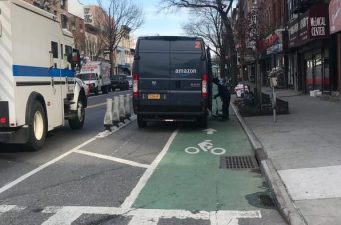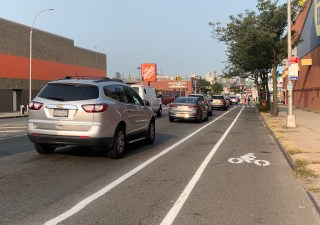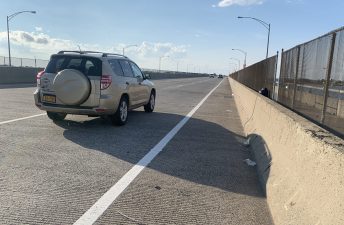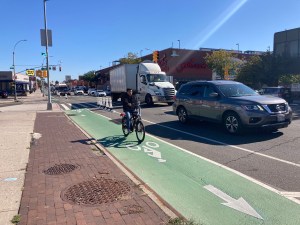DOT Announces ‘Better Barriers’ in Shift to Protect Bike Lanes Faster

Say goodbye to Jersey.
The city Department of Transportation announced Friday morning that it will shift its bike lane hardening initiative away from bulky Jersey barriers in favor of lower and “easier to install” materials such as curb-height blocks, wave delineators, armadillo-shaped speed bumps and other features to keep cars out of bike lanes.

The new “Better Barriers” initiative is meant to speed up the administration’s promise to harden 50 percent of the existing protected bike lanes that don’t actually have materials to prevent cars from hitting cyclists. Initially, DOT Commissioner Ydanis Rodriguez hoped to do the 20 miles or so of hardening in his first hundred days, but that timeline was pushed back until the end of 2023.
With this initiative, the DOT says it hopes to work faster.
“If effective, these barriers would greatly expand protections for cyclists with materials that are easier to install on a broader set of streets,” the agency said in a statement.
The agency said it would be evaluating costs during the pilot, but anticipates that they will be lower because the new barriers are much lighter and easier to store than Jersey barriers, and therefore can be deployed faster and with less need for heavy machinery.
The agency also said they are more visually appealing than Jersey barriers.

The key words there are “if effective.” Such low-rise barriers are the standard in cities around the world — cities around the world that additionally have decades of experience reducing car volumes and boosting biking culture. If New York’s experience with heavily protected bike lanes is any indication, drivers in the Big Apple may still be inclined to drive over the lower barricades.
And many American cities have moved to use these kinds of lower barricades to set up bike networks quickly, as Streetfilms revealed during a recent visit to Washington:
That said, the Adams administration spoke in one voice — repeating one theme — when it comes to the better-looking, easier-to-deploy barricades: creativity.
“My administration is going to be creative in finding and testing tools that can help us protect cyclists, and we will find the solutions that work for our communities to give New Yorkers the safe streets they deserve,” Mayor Adams said in a statement.
Deputy Mayor for Operations Meera Joshi added: “Our growing bike riding population deserves well designed protection, and the Adams Administration is committed to bringing creative infrastructure to our streets.”
And Rodriguez pulled out the thesaurus: “The Better Barriers pilot is an example of the innovative ways we are addressing traffic safety and improving our cycling network.”
The Better Barriers pilot will launch its first installation on Saturday on Union Square East between 15th and 17th streets. Subsequent locations are:
- Avenue C between Third and 13th streets in Manhattan.
- Quay Street between Franklin and West streets in Brooklyn.
- Multiple blocks on the 34th Avenue open street in Queens.
- Northern Boulevard between 41st Avenue and 36th Street in Queens.
- The Edward L. Grant Highway between Plimpton Avenue and West 169th Street in the Bronx (this is a protected bus lane test).
The DOT has set up a webpage for New Yorkers to give their feedback. Click here to respond.
Initial reaction has been positive.
“This type of innovative, quick-build bike lane protection can be a game-changer for keeping people safe, and the sooner DOT can put these barriers into place, the better,” said Eric McClure of StreetsPAC. “Feeling protected is a major factor in choosing to bike, and keeping drivers out of bike lanes will greatly improve safety and encourage more biking, which in turn improves safety — it’s a virtuous cycle.”
McClure added that “durability is of course a concern, what with snowplows’ ability to rip up street infrastructure.”
But because it’s a pilot program, “We should know very quickly which of these treatments work most effectively to keep drivers at bay, and DOT should make sure it can procure and deploy them as rapidly as possible.”
Others were also cautious:
“The Better Barriers program is an exciting commitment to safety and livability,” said Sara Lind, director of Policy at Open Plans (a sister organization of Streetsblog). “For too long, new bike lanes have been given the same flimsy plastic barrier or coat of green paint. Exploring innovative options will generate bike lanes that are not only functional and safe but aesthetically pleasing. It could be a huge step forward for both safety and quality of life and we’re glad to see the administration make this a priority.”
In addition, Bike New York tweeted:
We very much welcome this experimentation, but when & where will we see it?
Also, @NYC_DOT, we’re monitoring your “hardened” bike lanes & simply putting barriers or partial barriers along the edges of the lanes isn’t sufficient to keep them clear, as we’ve warned since January https://t.co/M7PnxI5JkN
— Bike New York (@bikenewyork) June 10, 2022
This is a breaking story and will be updated soon.




